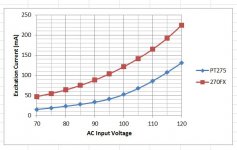You might compare with an ordinary DMM (non-RMS) to see how bad the waveform is - they'll agree at lower levels but diverge near saturation as the waveform gets more peaked.
Here's the comparison between the Musical Power Supplies PT275 V2 and the Hammond 270FX. The excitation current of the Hammond was much higher than expected. In both transformers, the excitation starts out pretty linear, then takes off after ~100VAC. Both transformers are edgeing into saturation at high input voltage. I can see now why the Hammond has a rep for buzzing and heating up...
Attachments
^how about extending to say 180 volts? only goes to show that the Hammond has fewer turns than the china job....
yes, but it is interesting to find if the 2 curves will ever meet at some point...180 is not too high to cause saturation if testing only for a few minutes or even seconds...when they meet it will mean that the hammonds are using better quality irons...
heating up at idle and buzzing under load are two different things...
heating up at idle and buzzing under load are two different things...
no problem, so from your results, the china traffo is actually better than the Hammond traffo......we can stop at that...i would also bet that the china traffo has a higher primary dc resistance than the Hammond indicating that it had more primary turns to explain the lower idle current....
Yes, both transformers are already gently entering saturation at below their rated voltage. Adding a secondary load will help, as the effective primary voltage will drop due to resistance.
It would be interesting to compare an expensive transformer, such as a Sowter.
It would be interesting to compare an expensive transformer, such as a Sowter.
I test transformers at 144V 60 Hz (20% high) as a quick check of 50 Hz capability - if current rises rapidly with voltage, it isn't good for 50 Hz. The Hammond isn't rated for 50 Hz so has fewer primary turns. 10% more turns or 20% more core area is required for 50 Hz to give the same core flux as at 60. 10% more wire either way... there ain't no free lunch.
As a note, both transformers were tested at 60 Hz, and the PT275 was tested using its 120V tap - a best-case scenario. Both of the transformers are wound for 115V service only. I have heard that the 115/230V Hammonds are better quality, but I don't have one around to test this. All the rest of my power suppply iron is OOS. It might be interesting to take one of my old Fisher power transformers and subject it to the same test. I also have some old Halldorson iron that might be worth a try.
- Status
- Not open for further replies.
- Home
- Amplifiers
- Tubes / Valves
- Problems with PT325.2i
